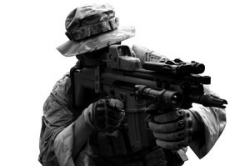CUSTOM-MADE FOR THE SPECIAL FORCES
PHOTO // Courtesy of Fabrique Nationale de Herstal
Fully modular and lightweight, the Special Operations Forces Combat Assault Rifle (SCAR) system is a perfect fit for the fluid and harsh environments in which special forces operate.
When the United States Special Operations Command (US SOCOM) began its search for a new primary weapon back in 2003, it had only two key issues in mind: reliability and accuracy.
This was made clear by the high number of reliability issues that its forces faced in Afghanistan with the then-primary weapon of the US special forces, the Colt Mark 18 Close Quarters Battle Receiver (CQBR) rifle, which was essentially a modified version of the M4A Carbine. CQBR refers to the top "receiver" half of the rifle that is designed specifically for close-quarter battle.
The US SOCOM eventually decided on the SCAR series made by Belgian company Fabrique Nationale de Herstal after a year of scouring the market. The SCAR family of rifles was designed from scratch specifically for the US special forces. Besides boasting high reliability and accuracy, it comes in variants that support different ammunition calibres.
There are three platforms in the SCAR series: two rifles chambered for 5.56mm and 7.62mm rounds respectively and a grenade launcher. The 5.56mm variant is known as the SCAR-Light (SCAR-L), while the 7.62mm version is called the SCAR-Heavy (SCAR-H). Both rifles come in 16-inch (40.64cm) and 13-inch (33.02cm) barrel versions. The long-barrel variant (for battles in open spaces) and short-barrel variants (for combat in confined areas) of the SCAR-L and SCAR-H are distinguished by the suffixes Close Quarters Combat (CQC) and Standard (STD), respectively.
Dependable weapon
For a special forces trooper whose life depends on the reliability of the weapon in his hand, a dependable rifle means more time to shoot the enemy and less time spent rectifying malfunctions.
During tests conducted by the US SOCOM, 6,000 rounds per rifle were fired under extremely dusty conditions and the SCAR rifles scored the best perfomance - suffering only 226 stoppages. The low failure rate was achieved by attention to detail: SCAR rifles have a gas-operated firing mechanism which does not blow dust and ammunition into its chamber - an improvement over the Mark 18 CQBR rifles.
The ease of maintenance by shooters was also improved. In the hands of a soldier experienced in the weapon, the rifle can be disassembled into its five component parts - butt stock, receiver, bolt carrier, trigger module and magazine - in less than 20 seconds.
Combined with easily learnt maintenance drills, the SCAR family of weapons guarantees a low failure rate even in the harshest environment.
Shooter friendly
Designed around the shooter, the SCAR rifles feature advanced ergonomics which work to reduce fatigue. All controls such as the firing rate selector, charging handle and magazine release buttons can be easily operated by both left- and right-handed shooters.
SCAR rifle butt stocks have up to six length settings that are controlled by a button located at the top of the butt assembly. This click-and-go design of the rifle is especially useful in the addition and removal of accessories such as optical sights and carrying handles.
With an in-built mounting system at the top and bottom of the rifle, compatible accessories can be slid on and off with ease. Known as Picatinny Rails , this system comprises a series of ridges with T-shaped cross-sections which allow shooting accessories to be placed at any position along the rail, fastened by thumbscrews or spring-loaded rail-grabbers .
This modular system means the shooter can customise the rifle according to his size and the requirements of the operation. When optical sights such as night-vision scopes are added, the default fore iron sights can be folded down to give unobstructed vision again, without the need for any special tool.
Add-on lethality
More firepower is also available in the form of the 40mm FN40GL Grenade Launcher. This add-on can be attached to the lower Picatinny Rail of the rifle and the launcher opens to the side to allow for the loading of grenades. Once attached, its dedicated trigger sits below the SCAR rifle s main trigger, enabling the shooter to fire the rifle and deploy grenades rapidly.
In addition, the FN40GL launcher may be used as a standalone weapon when attached to a bare butt-stock accessory.
The first of the SCAR rifles were issued to operational US Special Forces in April 2009 and a battalion of US Rangers has been deployed into combat with 600 of these rifles.










